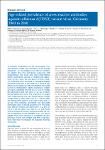Age-related prevalence of cross-reactive antibodies against influenza A(H3N2) variant virus, Germany, 2003 to 2010
Blümel, Benjamin
Schweiger, Brunhilde
Dehnert, Manuel
Buda, Silke
Reuss, Annicka
Czogiel, Irina
Kamtsiuris, Panagiotis
Schlaud, Martin
Poethko-Müller, Christina
Thamm, Michael
Haas, Walter
To estimate susceptibility to the swine-origin influenza A(H3N2) variant virus (A(H3N2)v) in the German population, we investigated cross-reactive antibodies against this virus and factors associated with seroprotective titre using sera from representative health examination surveys of children and adolescents (n = 815, 2003–06) and adults (n = 600, 2008–10). Antibodies were assessed by haemagglutination inhibition assay (HI); in our study an HI titre ≥ 40 was defined as seroprotective. We investigated associated factors by multivariable logistic regression. Overall, 41% (95% confidence interval (CI): 37–45) of children and adolescents and 39% (95% CI: 34–44) of adults had seroprotective titres. The proportion of people with seroprotective titre was lowest among children younger than 10 years (15%; 95% CI: 7–30) and highest among adults aged 18 to 29 years (59%; 95% CI: 49–67). Prior influenza vaccination was associated with higher odds of having seroprotective titre (odds ratio (OR) for children and adolescents: 3.4; 95% CI: 1.8–6.5; OR for adults: 2.4; 95% CI: 1.7–3.4). Young children showed the highest and young adults the lowest susceptibility to the A(H3N2)v virus. Our results suggest that initial exposure to circulating seasonal influenza viruses may predict long-term cross-reactivity that may be enhanced by seasonal influenza vaccination.
No license information
Related Items
Show related Items with similar Title, Author, Creator or Subject.
-
2016-02-18ZeitschriftenartikelVaccine effectiveness in preventing laboratory-confirmed influenza in primary care patients in a season of co-circulation of influenza A(H1N1)pdm09, B and drifted A(H3N2), I-MOVE Multicentre Case–Control Study, Europe 2014/15 Valenciano, Marta; Kissling, Esther; Reuss, Annicka; Rizzo, C.; Gherasim, A.; Horváth, Judit K.; Domegan, L.; Pitigoi, Daniela; Machado, Ausenda; Bella, A.; Paradowska-Stankiewicz, I.; Larrauri, A.; Ferenczi, A.; O´Donell, Joan; Lazar, M.; Pechirra, P.; Korczyńska, M. R.; Pozo, Francisco; Moren, A.Influenza A(H3N2), A(H1N1)pdm09 and B viruses co-circulated in Europe in 2014/15. We undertook a multicentre case–control study in eight European countries to measure 2014/15 influenza vaccine effectiveness (VE) against ...
-
2016-10-13ZeitschriftenartikelImproving influenza virological surveillance in Europe: strain-based reporting of antigenic and genetic characterisation data, 11 European countries, influenza season 2013/14 Broberg, E.; Hungnes, Olav; Schweiger, Brunhilde; Prosenc, Katarina; Daniels, R.; Guiomar, R.; Ikonen, N.; Kossyvakis, A.; Pozo, Francisco; Puzelli, S.; Thomas, I.; Waters, A.; Wiman, Å.; Meijer, AdamInfluenza antigenic and genetic characterisation data are crucial for influenza vaccine composition decision making. Previously, aggregate data were reported to the European Centre for Disease Prevention and Control by ...
-
2013-02-14ZeitschriftenartikelEarly estimates of seasonal influenza vaccine effectiveness in Europe: results from the i-move multicentre case–control study, 2012/13 Valenciano, M.; Kissling, E.We conducted a test-negative case–control study based in five European sentinel surveillance networks. The early 2012/13 adjusted influenza vaccine effectiveness was 78.2% (95% CI: 18.0 to 94.2) against influenza B, 62.1% ...

